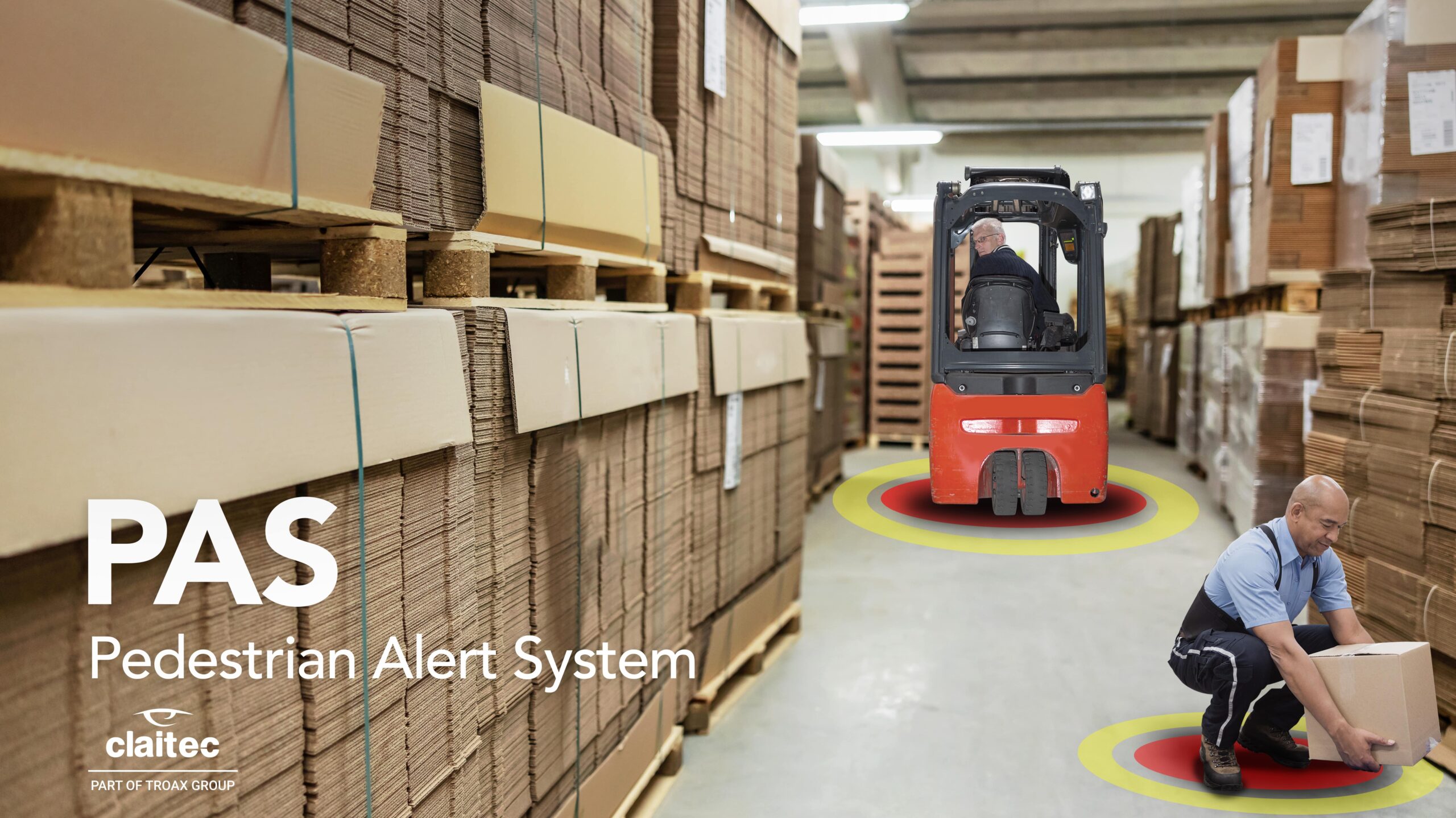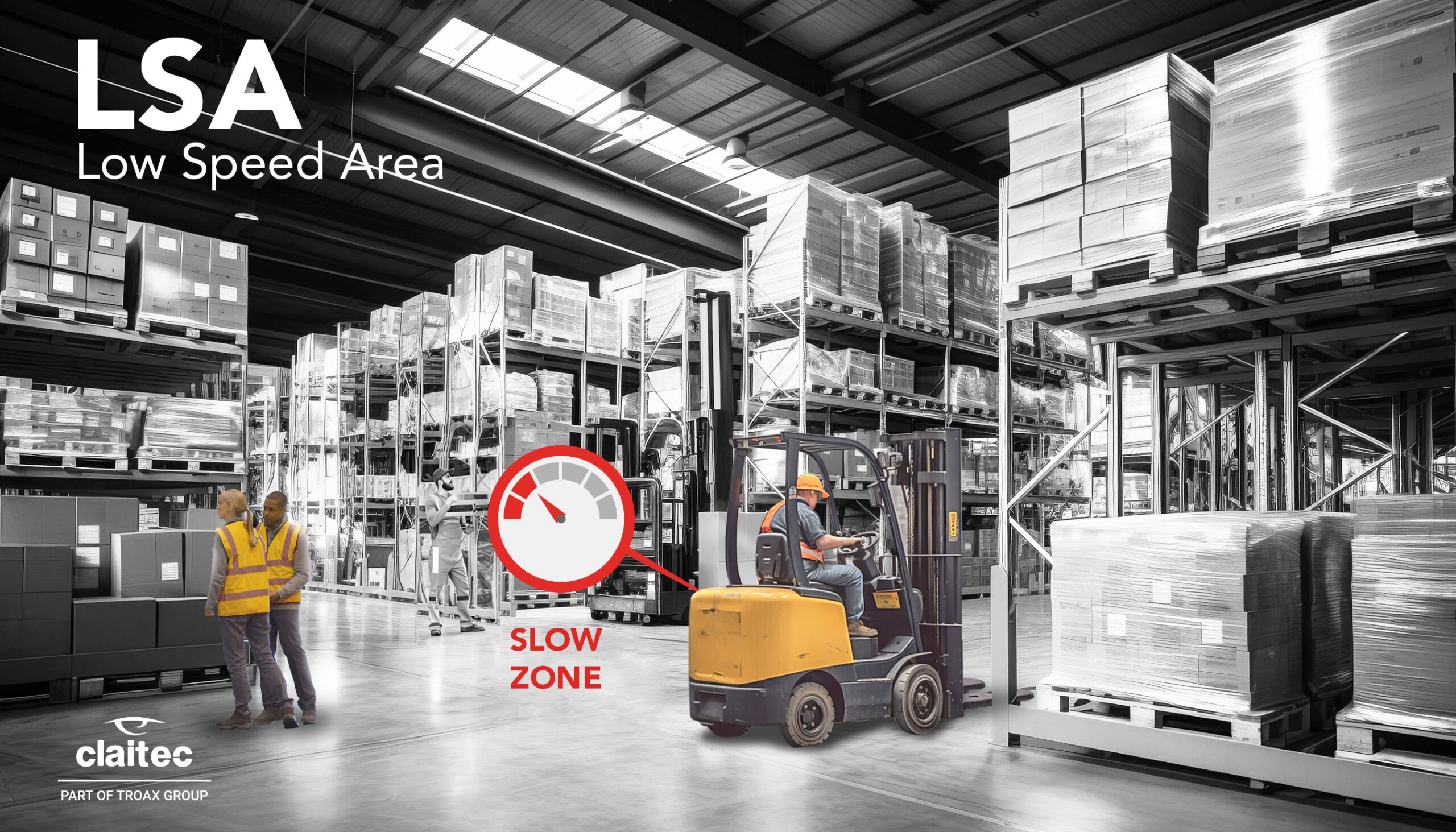
Forklifts greatly facilitate work in warehouses and industrial areas, especially in places where cargo transportation is constant. However, they also pose a significant risk and, unfortunately, are responsible for most accidents in these environments.In this post, we share five solutions developed by Claitec that help optimise safety in workspaces where forklift circulate. Claitec has developed many other solutions – and our experts are constantly searching for improvements and identifying situations in which to intervene to prevent accidents at work.
However, for now, we invite you to learn about five of the most popular solutions that significantly improve forklift-related safety.
1-. PAS (Pedestrian alert system):
We have talked extensively about this solution in many of our blog posts. The reason is simple: the purpose of this safety system – one of Claitec’s most important products – is to identify pedestrians that share working spaces with hazardous vehicles in industrial areas. This solution alerts both workers and forklift drivers, allowing them to take the necessary precautions to prevent collisions.
By equipping vehicles with a simple detection system – the AV-50 -, and by equipping workers with a personal tag, it’s possible to avoid accidents and collisions that often have drastic consequences. After years of implementing the system in different industries, the PAS solution has become one of the most effective and demanded solutions developed by the team at Claitec. We all know that people are a company’s main asset and it’s everyone’s duty to do everything in our power to protect them. That’s why the PAS System is our most sought-after safety solution.
2-. LSA (Low speed area):
Another of the main challenges in preventing forklift accidents lies in maintaining the appropriate speed in areas where traffic is fluid, where pedestrians coexist with these vehicles, or in areas of reduced visibility such as warehouse entrances and exits. Speed is a crucial factor in reducing risky situations, many of which can be prevented.
The LSA solution created by Claitec focuses on controlling speed in previously delimited areas through different sensors installed both on the forklifts and in the environment. Its operation is simple and highly effective. Supports equipped with reflective sensors are placed to detect the forklift as it circulates towards an area where it must reduce its speed. Then, the control unit located in the forklift acts by controlling the speed in the entire delimited area. The LSA solution can be adapted to different needs.
At Claitec, we have the experience and the necessary team to study each case individually and offer the best possible solution.
3-. CAS (Collision alert system):
Collisions are also frequent, particularly in spaces with high confluence of traffic and little mobility to manoeuvre. In such circumstances, collisions between vehicles are common and the damage can be high both at the human and economic level.
At Claitec we have developed a solution that addresses this type of risk: the CAS-G2 system. Equipping forklifts with this device helps configure a safety zone around the vehicle. The system then detects the presence of other vehicles in that zone of action which are also equipped with the same CAS system. As soon as the vehicle is detected, the driver receives a visual and audible alert that warns him/her of the presence of another forklift, thus preventing a potential collision. In addition, the sensor can tell different types of machinery apart, such as AGVs. You can find out more about the CAS system by visiting our products section.
4-. HLS (High load sensor):
Good practices in the transportation of goods are essential to prevent risky situations. One of the factors that often contributes to causing potential dangers is an excess of load. When the transported material exceeds the height previously configured to meet the environment’s physical characteristics, the HLS sensor warns drivers of the excess load, allowing them to take the necessary precautions.
The high load or a load above the recommended weight/height is usually the cause of collisions with the structure of the manoeuvre area, either due to lack of visibility, a miscalculation, or a driver’s oversight. With this solution, at Claitec we seek to reduce this type of accident and prevent greater complications.
5-. Copilot:
When we talk about forklifts, it’s important not only to consider the risks involved when they are operational. Forklift maintenance is equally important, since a vehicle in poor condition can provoke many dangerous situations. Claitec has designed a specific solution to control the proper condition of forklifts before use: the Copilot system.
This system performs a periodic check of the status of the forklifts through a series of questions that the driver must verify under their responsibility. Once the status of the vehicle has been verified, the Copilot determines if the machine meets the conditions for safe use. While this is the key function of the Copilot system, its uses and advantages are extensive, including the possibility of configuring it through the Safeyu platform, also developed by Claitec. We’ll delve deeper into this platform in future blog posts.
At a time when technology changes at such a rapid and unpredictable rate, Claitec’s philosophy is to continue creating, researching and contributing all our experience to improve the safety of people in their respective workplaces.
We invite you to discover our many other safety solutions by visiting our products section, and we encourage you to contact us to help you answer any questions you may have, or to make an appointment with our experts. We will be happy to assist you any time!










